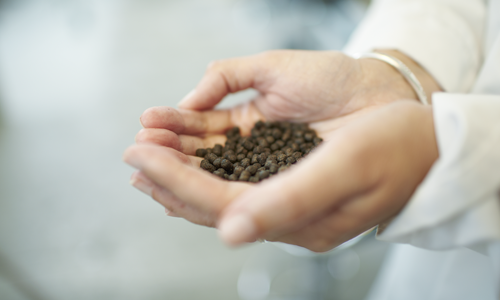Fish feed has undergone a major transformation in the last 10 years. Pictured is a plant-derived trial feed produced by the APC for rainbow trout. Credit: Bård Gudim
Norwegian researchers have been leading an international effort to make aquaculture more sustainable. In 10 years they have revolutionised fish feed.
The Aquaculture Protein Centre (APC) was among the initial 13 Norwegian Centres of Excellence (SFF) established. After ten years, its activities as an SFF centre are now drawing to a close.
The centre was established to generate the knowledge needed to be able to replace fishmeal in aquaculture feeds. After ten years, the proportion of fish-based ingredients has been reduced to roughly ten per cent, while fish farmers have doubled their production.
Fish going vegetarian
APC Director Margareth Øverland believes that climate change and the increasing global need for food have given new urgency to the need to find feed ingredients that cannot be used directly as human food. The APC has shown that fish production is possible without the use of fishmeal.
"In trials with rainbow trout, we've recently achieved normal growth rates with feed that contains no fishmeal," says Dr Øverland. "The fish showed no signs of disease either." Nevertheless she believes that fish feed of the future will still contain some marine ingredients, both to make the feed taste better to the fish and to ensure that the fish contain healthy omega fatty acids.
"Salmon, our main production species, is not adapted to a vegetarian diet by nature. So it is critical that we find out how vegetable proteins affect fish growth, digestion and the immune system. One challenge is that plants contain anti-nutrients, which are substances that protect the plants from pests and disease, but which also inhibit fish growth and can trigger gut inflammation."
Important discoveries
The research areas of the APC are divided between the Norwegian University of Life Sciences (UMB), the Norwegian School of Veterinary Science (NVH) and the Norwegian Institute of Food, Fisheries and Aquaculture Research (Nofima). While UMB has been exploring new feed ingredients and processing methods as well as optimal utilisation of nutrients, NVH has been studying how various diets affect fish gut health.
The Aquaculture Protein Centre was established to generate the knowledge needed to be able to replace fishmeal in aquaculture feeds. Credit: Bård Gudim
"Our researchers have learned a great deal about the fish immune system and digestion," continues Dr Øverland, "and we have developed an advanced set of tools with a number of new markers to measure responses in fish." She also highlights the findings of research carried out at Nofima on APC's third priority area: fish requirements for proteins and amino acids.
"The APC has generated comprehensive knowledge about the nutrient requirements of fish. Determining amino acid requirements has been particularly important for developing feeds, both for efficient utilisation of different protein sources and for adapting feeds to fish in their various stages of life."
From wood waste to good taste
Bacteria, yeast, algae and animal by-products are becoming increasingly desirable as feed ingredients. This summer the EU approved the use of animal by-products in Europe, and Norway is expected to follow suit. Recent technological developments have made it possible to utilise yeast to convert wood chips into a high-value protein source, and the latest APC trials offer hope for a future fish feed based on this conversion.
"We also find that meal based on bacteria grown on natural gas can neutralise some of the negative effects of vegetable proteins such as those relating to the development of stomach and intestinal disorders. And we have seen positive health effects in trials where fishmeal was replaced with yeast." This autumn Professor Øverland is starting up a new project using microalgae.
Knowledge for the future
Collaboration with other Norwegian and international research groups has been essential to the APC's success.
"Our research partners in Europe, the US and Asia have been important contributors to the collective knowledge base. A third of our researchers have been guest researchers from other countries," says Professor Øverland. "And our partners have told us that many of the APC's results from salmon research are relevant for other species as well."
The centre's research findings have been implemented by industry at a rapid pace, especially considering that the APC has primarily been carrying out basic research.
"We have investigated new feed ingredients, applying our knowledge about fish tolerances to anti-nutrients and fish nutritional requirements. We've also sought to meet the industry's needs, such as fish welfare, profitability and sustainability."
After ten years, APC can apply its valuable knowledge bank to studying the interaction between genetics, nutrition, health and technology.
"Recently developed DNA techniques give us a more complete understanding of the many biological processes in fish that eat different types of feed. When the salmon genome is fully sequenced next year," says Professor Øverland, "we will have more and better tools for identifying and selectively breeding individuals that tolerate these new diets better."
Provided by The Research Council of Norway

.png)




















